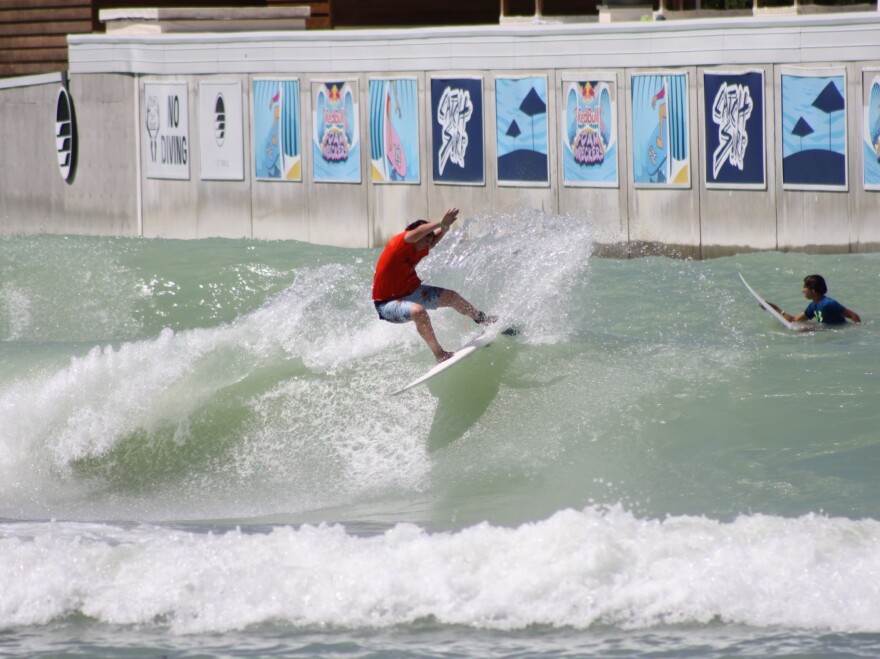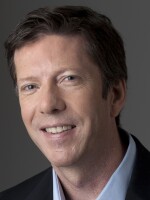Nearly 200 miles from the nearest ocean, nine surfers are bobbing beneath the Texas sun in what looks like a tropical lagoon.
Then a sound like a muffled jet engine fills the air, overwhelming a reggae song coming from shore.
One surfer starts to paddle, and a head-high wave rises seemingly from nowhere to carry him down the line toward the sandy beach.
Seconds later, two more waves materialize and two more surfers glide off.
One of them is 12-year-old Dane Grochowski.
"I pumped down the line and did a little snap, and kind of got caught behind the section" he says, when I wade out to ask him about his ride. "So I pulled into the barrel. But I wasn't going to make it out."
Welcome to the BSR Surf Resort in Waco, Texas, where the machine-made waves are so good they attract top professionals as well as casual surfers.
Hawaiian surfer Carissa Moore trained here and at a similar wave pool in Japan before she won a gold medal at the Tokyo Olympics this summer.
Grochowski and his family made the trip from Pacifica, Calif. after seeing videos of the wave. "It feels like an adventure coming here 'cause it's in the middle of nowhere," Grochowski says.
The BSR resort has become an emblem of how a new generation of artificial waves is redefining inland surfing. It's now clear that if you build the right wave, even in central Texas, surfers will come — and shred.

Compressed air and a computer
The BSR Surf Resort is the result of decades of progress in both the science and technology of wave making.
The wave here is generated by powerful fans that sit behind a concrete wall running along one side of the surf pool. The rest of the pool is bordered by a sandy beach, complete with cabanas and a lifeguard tower.
The fans compress air that is directed to a series of underwater chambers along the wall.
"There's a proprietary way that that air gets released," says Mike Schwaab, a surfer who is also the resort's general manager. "It displaces water and that specific displacement, paired with the way that the concrete bottom is designed, is what creates a breaking wave."
And a good one. The waves I rode during an intermediate session compared favorably to the ones I once surfed as a teenager in Southern California.
The system in Waco was designed by American Wave Machines in Solana Beach, Calif. It's one of several companies that uses air pressure to generate surfing waves. Other companies use paddles, plungers, pistons, or even a hydrofoil dragged through the water.
In Waco, a computer algorithm controls the size, shape, and direction of each wave. "You can have a beginner wave, you can have an expert wave, you can have a wave specifically to get barreled," Schwaab says, referring to a ride that puts a surfer inside the curl of a breaking wave.

Artificial waves have been around for decades. Disney World, for example, opened its Typhoon Lagoon Surf Pool in 1989. But the waves in these pools tended to be slow and mushy. They were designed for bathers, not surfers.
Then in 2015, 11-time World Surf League champion Kelly Slater unveiled a different kind of wave.
It breaks in an abandoned water ski park in central California. A massive hydrofoil is propelled through the water to generate the sort of fast, barreling wave that surfers' dreams are made of.
But Slater's wave, now controlled by the World Surf League, was never meant for the surfing masses. The machine produces about 15 waves an hour and riding just one costs hundreds of dollars. The Waco machine can make 120 waves an hour and costs surfers about $10 a ride.
That makes the wave pool commercially viable. Sessions in Waco are generally sold out weeks ahead of time. And the success is encouraging other resorts and water parks to add their own state-of-the-art surf pools.
A wave grows in Waco
Like many water parks, the one in Waco was built for a sport other than surfing.
"The dude that put it all together was a barefoot water skier and this whole place started based on barefoot water skiing," Schwaab says.
It opened as the Barefoot Ski Ranch in 2012. Over time, the facility added a lazy river, an extreme water slide and a wakeboarding course built around an island that is home to a family of lemurs.
The BSR surf pool opened in 2018. Within weeks, a pro named Seth Moniz landed a back flip on the air section and the video went viral.
That attracted a lot of big-name surfers. But it also brought inexperienced surfers who wanted a good place to learn.
"When I started I was a beginner," says Brian Fillmore, a Texas native who landed a job as the wave pool's manager. "Now I'm able to get barreled, do airs, [and I'm] working on perfecting my turns just like every other surfer."
Inventing the "freak peak"
Surfers often talk about finding the perfect wave. But they don't want to ride the same perfect wave over and over, says Dave Likins, the facility's chief operating officer.
"If it's not changeable, and it's not something that's going to be a little bit different each time, you're eventually going to get bored," Likins says.
So the Waco wave was designed to be customized, just by changing a computer algorithm.
"We had an event recently out here that Rip Curl did called the GromSearch, and American Wave Machines put a new wave in, a wave that nobody had seen," Likins says.
The most radical wave in Waco is the Freak Peak. It's produced when two swells collide to form a wedge that serves as a launch pad for the bold.
But even the standard waves in Waco can challenge surfers used to catching ocean swells.
Rebecca Carr, who traveled from California with her husband and their three kids, nearly gave up after her first session.
"You can only [catch it] in one spot, so you have to be good to get in these waves," she says.
Carr figured it out, though. So did I, after botching a few waves.
And Carr says she and her family will definitely return.
"I grew up two hours from here in Granbury, Texas," she says. "So this is our family vacation every year and it just turns out now we can surf when we're in mid Texas."
Copyright 2021 NPR. To see more, visit https://www.npr.org. 9(MDAxODQzOTgwMDEyMTcyNjI4MTAxYWQyMw004))



